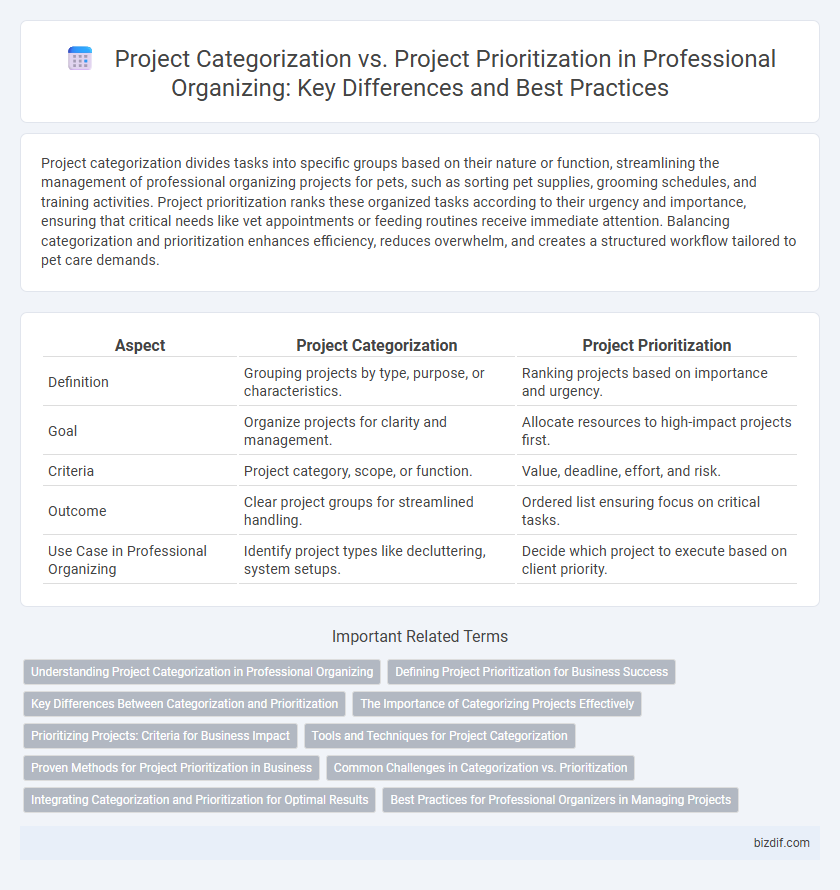Project categorization divides tasks into specific groups based on their nature or function, streamlining the management of professional organizing projects for pets, such as sorting pet supplies, grooming schedules, and training activities. Project prioritization ranks these organized tasks according to their urgency and importance, ensuring that critical needs like vet appointments or feeding routines receive immediate attention. Balancing categorization and prioritization enhances efficiency, reduces overwhelm, and creates a structured workflow tailored to pet care demands.
Table of Comparison
| Aspect | Project Categorization | Project Prioritization |
|---|---|---|
| Definition | Grouping projects by type, purpose, or characteristics. | Ranking projects based on importance and urgency. |
| Goal | Organize projects for clarity and management. | Allocate resources to high-impact projects first. |
| Criteria | Project category, scope, or function. | Value, deadline, effort, and risk. |
| Outcome | Clear project groups for streamlined handling. | Ordered list ensuring focus on critical tasks. |
| Use Case in Professional Organizing | Identify project types like decluttering, system setups. | Decide which project to execute based on client priority. |
Understanding Project Categorization in Professional Organizing
Project categorization in professional organizing involves sorting tasks into distinct groups based on characteristics like urgency, required resources, or functional area, enabling clearer focus and streamlined workflows. This classification helps organizers allocate time and resources more effectively by grouping related activities, which supports strategic planning and reduces overwhelm. Understanding project categorization enhances decision-making processes by clarifying which projects share common goals or constraints before determining their priority levels.
Defining Project Prioritization for Business Success
Project prioritization involves ranking tasks and initiatives based on criteria such as impact, urgency, and resource availability to drive business success. Unlike project categorization, which groups projects by type or function, prioritization ensures that the most valuable and time-sensitive projects receive immediate attention. Effective project prioritization optimizes resource allocation and accelerates goal achievement in professional organizing environments.
Key Differences Between Categorization and Prioritization
Project categorization organizes tasks into groups based on shared characteristics such as type, department, or goal, facilitating easier management and resource allocation. Project prioritization ranks tasks according to their urgency, impact, and deadlines to determine the order of execution that maximizes productivity. The key difference lies in categorization focusing on sorting and grouping, whereas prioritization emphasizes decision-making for action sequencing based on value and time sensitivity.
The Importance of Categorizing Projects Effectively
Effective categorization of projects streamlines workflow by grouping tasks based on common attributes such as deadlines, resources, or impact, making it easier to allocate time and effort strategically. Organized categories enhance visibility into project requirements, reduce cognitive overload, and improve decision-making accuracy compared to mere prioritization alone. This structured approach increases productivity by enabling professional organizers to manage multiple projects efficiently without overlooking critical details.
Prioritizing Projects: Criteria for Business Impact
Prioritizing projects involves assessing potential business impact through criteria like return on investment, resource availability, and alignment with strategic goals. Effective project prioritization maximizes productivity by focusing efforts on initiatives that deliver the highest value and competitive advantage. Utilizing tools such as impact-effort matrices or weighted scoring models ensures decisions are data-driven and aligned with organizational priorities.
Tools and Techniques for Project Categorization
Effective project categorization relies on tools like mind mapping software, categorization matrices, and project management platforms that enable visual grouping of tasks by type, urgency, or resource needs. Techniques such as the MoSCoW method and Eisenhower Matrix help classify projects based on importance and feasibility, streamlining decision-making. Using these tools enhances clarity, ensures balanced workload distribution, and accelerates project initiation by organizing projects into defined categories before prioritizing them.
Proven Methods for Project Prioritization in Business
Project prioritization in business employs proven methods such as the Eisenhower Matrix, MoSCoW method, and Weighted Scoring Model, enabling organizations to rank projects based on urgency, impact, and resource availability. Project categorization segments tasks by type or department but does not inherently address the order of execution or resource allocation. Utilizing data-driven prioritization frameworks enhances decision-making efficiency, ensuring high-value projects align with strategic business objectives for optimal productivity.
Common Challenges in Categorization vs. Prioritization
Project categorization in professional organizing often encounters challenges such as overlapping categories and unclear classification criteria, leading to inconsistent sorting of tasks. Project prioritization struggles with balancing urgency and importance, resulting in misallocation of time and resources. Both processes demand clear guidelines and adaptable frameworks to effectively manage workload and enhance productivity.
Integrating Categorization and Prioritization for Optimal Results
Integrating project categorization and prioritization enhances professional organizing efficiency by grouping tasks into clear categories such as urgency, complexity, and resource requirements. This combined approach allows for strategic focus on high-impact projects while maintaining organized workflows aligned with specific goals. Utilizing tools like Eisenhower matrices or custom tagging systems supports seamless alignment of project categories with priority levels, optimizing time management and productivity.
Best Practices for Professional Organizers in Managing Projects
Project categorization involves grouping tasks by type, deadline, or client needs to streamline workflow and enhance clarity, while project prioritization ranks these tasks based on urgency, impact, and resource availability to optimize productivity. Professional organizers utilize tools like Eisenhower matrices and digital project management software to implement these best practices efficiently. Clear categorization combined with strategic prioritization improves time management, reduces stress, and ensures consistent project delivery.
project categorization vs project prioritization Infographic

 bizdif.com
bizdif.com